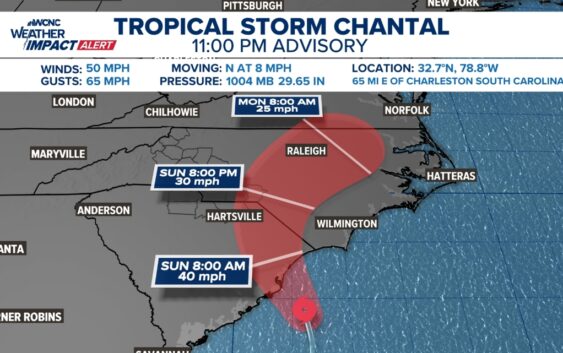- They couldn’t save their daughters’ lives in the July 4 floods. Now they’re dealing with the grief and the guilt.
- Austin could see heavy rains, possible flooding over the next few days
- Families of campers, counselors who died in Texas Hill County floods sue Camp Mystic
- Small plane bound for Jamaica with hurricane relief supplies crashes in Florida neighborhood
- Ask the Meteorologist: Did a tornado hit Johnston County Saturday night?
Tropical Storm Chantal makes landfall this morning near Myrtle Beach, South Carolina

A weather alert day has been issued for counties east of Charlotte as pockets of heavy rain could lead to localized flooding
CHARLOTTE, N.C. — Tropical Storm Chantal made landfall Sunday at 5 a.m., per the National Hurricane Center. It’s currently located about 70 miles northeast of Charleston, South Carolina.
A Tropical Storm Warning is in effect for South Santee River, S.C., to Surf City, N.C. A Tropical Storm Watch is in place from Edisto Beach, S.C., to South Santee River, SC.
Regardless of development, heavy rain has already begun for portions of the coastal Carolinas and gets heavier and more widespread overnight. Our impacts locally are minimal, with highest rain chances from Greensboro and Raleigh toward the beaches.
When
The highest impacts are well to our east across the coastal Carolinas. Chantal is an extremely lopsided system, so the worst rain and wind are far from the center.
Center comes onshore this morning with rain in the Charlotte area from late morning through midday. It’s in and out very quickly!
Impacts
- Coastal North Carolina and South Carolina are already seeing heavy rain and will continue this morning
- Rip current danger will be high throughout Monday for both the North and South Carolina beaches
- Marine conditions are rough and dangerous already, with wave heights up to 5-10 feet offshore
- Wind gusts along the Carolina shores could reach 20 – 30 mph
- Locally, watch for heavy rain Sunday before quickly moving out!
What you need to do and know
- Check forecasts daily, especially if you live in the Southeast, especially in coastal areas
- Be prepared for localized flooding or downpours, mainly near the coast and offshore.
- If you’re boating or at the beach, monitor marine warnings closely!
- Know what different beach flags mean and when it is, and isn’t, safe to swim.